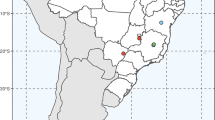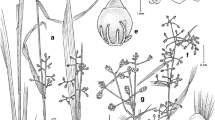Abstract
In order to elucidate the evolution of C4 syndrome, the taxonomic relationships, leaf anatomy, and ecological and global distribution of C3 and C4 species in the genusRhynchospora were investigated. The anatomical observation for 181 species revealed that 26 C4 species occurred within theCapitatae group of the subgenusHaplostyleae, a natural group showing highly advanced morphological characteristics, together with several C3 species. In spite of there being rather few C4 species, they possessed two kinds of Kranz anatomical structure differing from each other in the location of Kranz cells. Some C3 species ofCapitatae showed radial arrangement in mesophyll cells surrounding vascular bundles, which is distinguished from typical non-Kranz anatomy. The C4 species extended their ecological ranges from wet habitats to dry savanna grasslands, while the C3 species showed the best development in wet habitats. The C3 species were widespread from tropical to temperate regions with partial range extension into subarctic regions of both hemispheres, showing conspicuously high concentration of species in the New World, but being absent from arid climatic regions. The C4 species were distributed mostly in tropics and subtropics, showing two separate distributional centers in South and Central America and in Tropical Asia and Australia. The range of C4 species was nearly completely included in the C3 range. In conclusion, it seems that inRhynchospora the C4 syndrome evolved relatively recently, and arose in at least two separate phylogenetic trends in the tropics and the subtropics, more probably in the Neotropics.
Similar content being viewed by others
References
Björkman, O. 1976. Adaptive and genetic aspects of C4 photosynthesis.In: R.H. Burris and C.C. Black, ed., CO2 Metabolism and Plant Productivity p. 287–309. Univ. Park Press, Baltimore.
Black, C.C. 1971. Ecological implications of dividing plants into groups with distinct photosynthetic production capacities. Advan. Ecol. Res.7: 87–114.
Brown, W.V. andB.N. Smith. 1972. Grass evolution, the Kranz syndrome,13C/12C ratios, and continental drift. Nature239: 345–346.
—. 1975. Variations in anatomy, associations, and origins of Kranz tissue. Amer. J. Bot.62: 395–402.
—. 1977. The Kranz syndrome and its subtypes in grass systematics. Mem. Torr. Bot. Club23: 1–97.
Carolin, R.C., S.W.L. Jacobs andM. Vesk. 1977. The ultrastructure of Kranz cells in the family Cyperaceae. Bot. Gaz.138: 413–419.
Doliner, L.H. andP.A. Jolliffe. 1979. Ecological evidence concerning the adaptive significance of the C4 dicarboxylic acid pathway of photosynthesis. Oecologia38: 23–34.
Downton, W.J.S. andE.B. Tregunna 1968. Carbon dioxide compensation—its relation to photosynthetic carboxylation reactions, systematics of the Gramineae, and leaf anatomy. Can. J. Bot.46: 207–215.
—. 1975. The occurrence of C4 photosynthesis among plants. Photosynthetica9: 96–105.
Ehleringer, J.R. 1979. Photosynthesis and photorespiration: Biochemistry, physiology, and ecological implications. Hortscience14: 217–222.
Ellis, R.P., J.C. Vogel andA. Fuls. 1980. Photosynthetic pathways and the geographical distribution of grasses in South West Africa/Namibia. S. Afr. J. Sci.76: 307–314.
Evans, L.T. 1971. Evolutionary, adaptive, and environmental aspects of the photosynthetic pathway.In: M.D. Hatchet al., ed., Photosynthesis and Photorespiration p. 130–136. Wiley-Interscience, New York.
Gale, S. 1944.Rhynchospora, sectionEurhynchospora, in Canada, the United States and the West Indies. Rhodora46: 89–134, 159–197, 207–249, 255–278.
Hattersley, P.W., L. Watson andC.R. Johnston 1982. Remarkable leaf anatomical variations inNeurachne and its allies (Poaceae) in relation to C3 and C4 photosynthesis. Bot. J. Linn. Soc.84: 265–272.
Hulten, E. 1968. Flora of Alaska and Neighboring Territories: A Manual of the Vascular Plants. Stanford Univ. Press, Stanford.
Kanai, R. andM. Kashiwagi. 1975.Panicum milioides, a Gramineae plant having Kranz leaf anatomy without C4-photosynthesis. Plant Cell Physiol.16: 669–679.
Kern, J.H. 1974. Cyperaceae. Flora Malesiana I.7: 435–753.
Koyama, T. 1972. Cyperaceae-Rhynchosporeae and Cladieae. Mem. New York Bot. Gard.23: 23–89.
—. 1982. The genusLipocarpha R. Brown, its morphology and systematic position in the family Cyperaceae. Acta Phytotax. Geobot.33: 218–226.
Kükenthal, G. 1936. Cyperaceae-Scirpoideae-Cypereae. Pflanzenreich 101. IV.20: 1–671.
—. 1949–1951. Vorarbeiten einer Monographie der Rhynchosporideae. 18.Rhynchospora. Bot. Jahrb.74: 375–509;75: 90–195, 273–314.
—. 1952. Vorarbeiten einer Monographie der Rhynchosporideae. 19.Pleurostachys. Bot. Jahrb.75: 451–484.
Laetsch, W.M. 1974. The C4 syndrome: a structural analysis. Ann. Rev. Plant Physiol.25: 27–52.
Lerman, J.C. andJ. Raynal. 1972. La teneur en isotopes stables du carbone chez les Cypéracées: sa valeur taxonomique. Comp. Rend. Acad. Sci. Ser. D275: 1391–1394.
Maire, R. 1957. Flore de L’Afrique du Nord (Maroc, Algérie, Tunisie, Tripolitaine, Cyrénaique et Sahara). Vol. IV. Paul Lechevalier, Paris.
Metcalfe, C.R. 1971. Anatomy of the Monocotyledons. Vol. 5. Cyperaceae. Clarendon, Oxford.
Monson, R.K., G.E. Edwards andM.S.B. Ku. 1984. C3−C4 intermediate photosynthesis in plants. BioScience34: 563–574.
Moore, P.D. 1982. Evolution of photosynthetic pathways in flowering plants. Nature295: 647–648.
Moss, D.N., E.G. Krenzer andW.A. Brun. 1969. Carbon dioxide compensation points in related plant species. Science164: 187–188.
Osmond, C.B., O. Björkman andD.J. Anderson. 1980. Physiological Processes in Plant Ecology: Toward a Synthesis withAtriplex. Springer Verlag, Berlin.
—,K. Winter andH. Ziegler. 1982. Functional significance of different pathways of CO2 fixation in photosynthesis.In: O.L. Langeet al., ed., Encyclopedia of Plant Physiology, New Series Vol. 12B. Physiological Plant Ecology II. Water Relations and Carbon Assimilation p. 479–547. Springer Verlag, Berlin.
Powell, A.M. 1978. Systematics ofFlaveria (Flaveriinae-Asteraceae). Ann. Mo. Bot. Gard.65: 590–636.
Prendergast, H.D.V. andP.W. Hattersley. 1985. Distribution and cytology of AustralianNeurachne and its allies (Poaceae), a group containing C3, C4 and C3−C4 intermediate species. Aust. J. Bot.33: 317–336.
Raghavendra, A.S. andV.S.R. Das. 1978. The occurrence of C4 photosynthesis: A supplementary list of C4 plants reported during late 1974-mid. 1977. Photosynthetica12: 200–208.
Raynal, J. 1967. Notes Cypérologiques: 10. Les races Africaines et Malgaches deRhynchospora rubra (Lour.) Makino. Adansonia Ser. 2.7: 513–523.
—. 1973. Notes Cypérologiques: 19. Contribution a la classification de la sous-famille des Cyperoideae. Adansonia Ser. 2.13: 145–171.
Smith, B.N. andM.J. Robbins. 1974. Evolution of C4 photosynthesis. An assessment based on13C/12C ratios and Kranz anatomy.In: M. Avron, ed., Proceeding of Third International Congress on Photosynthesis.1: 1579–1588. Elsevier Sci. Publ. Co., Amsterdam.
Takeda, T., O. Ueno andW. Agata. 1980. The occurrence of C4 species in the genusRhynchospora and its significance in Kranz anatomy of the Cyperaceae. Bot. Mag. Tokyo93: 55–65.
——,M. Samejima andT. Ohtani. 1985. An investigation for the occurrence of C4 photosynthesis in the Cyperaceae from Australia. Bot. Mag. Tokyo98: 393–411.
Teeri, J.A. andL.G. Stowe. 1976. Climatic patterns and the distribution of C4 grasses in North America. Oecologia23: 1–12.
—— andD.A. Livingston. 1980. The distribution of C4 species of the Cyperaceae in North America in relation to climate. Oecologia47: 307–310.
Tregunna, E.B., B.N. Smith, J.A. Berry andW.J.S. Downton. 1970. Some methods for studying the photosynthetic taxonomy of the angiosperms. Can. J. Bot.48: 1209–1214.
Vogel, J., A. Flus andR.P. Ellis. 1978. The geographical distribution of Kranz grasses in South Africa. S. Afr. J. Sci.74: 209–215.
Author information
Authors and Affiliations
Rights and permissions
About this article
Cite this article
Ueno, O., Koyama, T. Distribution and evolution of C4 syndrome inRhynchospora (Rhynchosporeae-Cyperaceae). Bot. Mag. Tokyo 100, 63–85 (1987). https://doi.org/10.1007/BF02488421
Received:
Issue Date:
DOI: https://doi.org/10.1007/BF02488421




